Despite numerous traffic safety programs, traffic death rates have not declined in a decade and recently started to increase. We can do better! A new paradigm identifies additional safety strategies that reduce both crash rates and risk exposure.

During this holiday season thousands of North Americans will be unnecessarily killed or severely injured in crashes. We could do much better!
The United States has the highest traffic fatality rate among peer countries, nearly three times the European average and easily twice the averages of Australia and Canada.
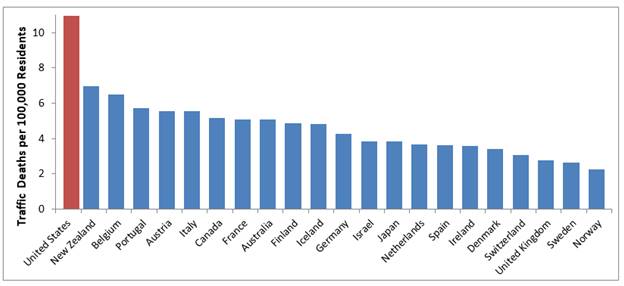
Similarly, within the United States, traffic fatality rates vary by four fold. What explains these differences? Do New York, San Francisco, and Cleveland, which have about four annual traffic deaths per 100,000 residents, have better traffic safety policies and programs than Birmingham, Miami, or Memphis, which have more than 16? No, don't blame high traffic death rates on inadequate traffic safety efforts, blame them on higher per capita vehicle travel, as illustrated below, and therefore automobile-dependent transportation planning and sprawl-inducing development policies; those are the true culprits.
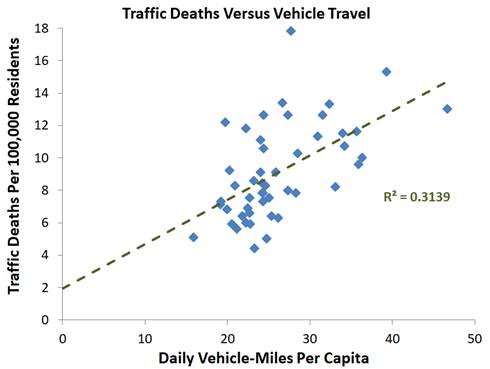
Current trends are not encouraging for automobile-dependent areas. During the last half century, U.S. distance-based and per capita traffic death rates declined significantly, but these declines stopped about a decade ago, and fatality rates increased in the last few years, as illustrated below.
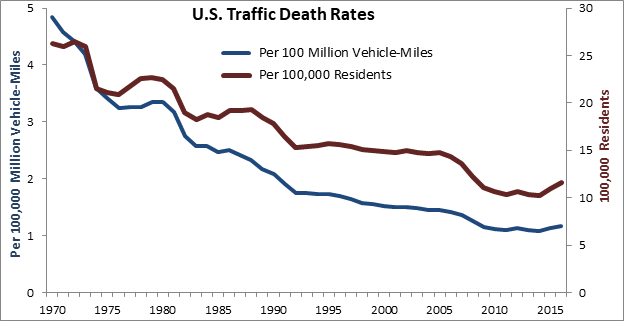
This indicates that new approaches are needed to achieve ambitious new traffic safety targets such as Road to Zero.
My recent report, "A New Traffic Safety Paradigm," examines factors that contribute to high crash rates, and identifies numerous potential safety strategies that are not being applied in most North American communities. In a word, the new paradigm recognizes exposure—the amount that people travel—as a risk factor. Total traffic crashes are the product of distance-based crash rates (such as casualties per 100,000 million vehicle-miles) times per capita vehicle travel; a change in either tends to cause similar changes in total crashes. My report describes numerous studies that use various methods and data sets to demonstrate this relationship. For example, the figure below shows the relationship between annual mileage and crashes among countries, indicating that the United States' high traffic death rate can be explained by its high per capita vehicle mileage. Similar patterns are found at regional and local geographic scales: areas with higher per capita vehicle travel generally have higher per capita traffic fatality rates.
Vehicle Mileage and Traffic Fatality Rates in OECD Countries
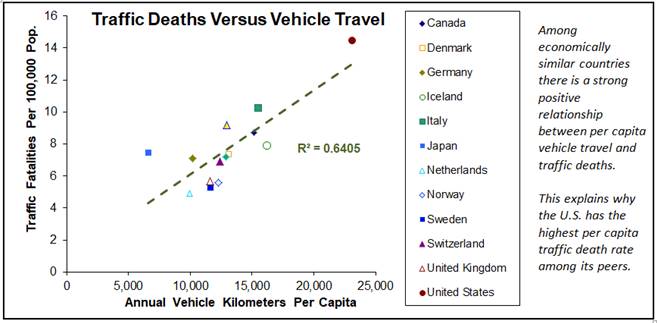
These relationships are dynamic: extensive research indicates that policies which increase vehicle travel, such as automobile-oriented transport planning, lower fuel prices, and sprawled development patterns tend to increase traffic casualty rates, and those that reduce vehicle travel, such as multimodal transport planning, public transit improvements, higher fuel prices and road user fees, and Smart Growth development patterns, tend to increase traffic safety. Increases in active transportation (walking and cycling) mode shares also tend to reduce total (all mode) traffic casualty rates, an effect called "safety in numbers."
To determine whether these strategies can be effective, I compared traffic fatality trends in three cities that emphasized multimodal planning (Denver, Portland, and Seattle) with three cities that have conventional, automobile-oriented planning (Atlanta, Houston, and Oklahoma City). Between 2004 and 2014 the multimodal cities experienced much larger traffic fatality rate reductions (47%) than the automobile-oriented cities (19%). This indicates that more multimodal planning can provide large safety benefits in less than a decade. Some new paradigm safety strategies, such as increased transit service, fuel and parking price increases, and commute trip reduction programs, can be implemented in just months.
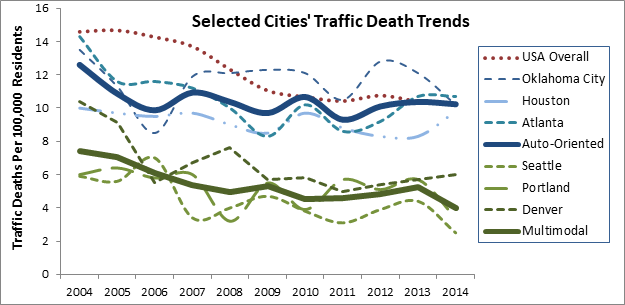
This very good news, because it identifies potential safety strategies not currently implemented by most North American traffic safety programs. The current traffic safety paradigm focuses almost entirely on distance-based crash rates, and generally ignores exposure as a risk factor. The new paradigm considers both distance-based crash rates and per capita vehicle travel as risk factors, and so recognizes the additional crashes caused by planning decisions that stimulate total vehicle travel, such as low fuel prices and sprawled development patterns, and the safety benefits of transportation demand management (TDM) strategies such as more multimodal planning, efficient transport pricing, Smart Growth development policies and TDM programs. Since these strategies provide large co-benefits besides safety, the new paradigm supports more comprehensive analysis which accounts for these impacts.
The table below summarizes fifteen New Paradigm traffic safety strategies, with an estimate of their typical crash rate reductions.
Fifteen New Paradigm Safety Strategies
Strategy |
Typical Crash Reductions |
|
Transit service improvements (more routes, frequency, etc.). |
Each 1% transit ridership gain typically reduces traffic casualties 1% or more. |
|
HOV and bus traffic priority |
Can reduce affected traveler’s crash rates 10-30%, and total rates 1-5%. |
|
Active transport improvements (better sidewalks, crosswalks, bikelane, etc.). |
Comprehensive active transport improvements can reduce resident’s total crash casualty rates 5-10%. |
|
Expanded carsharing services |
Reduce total crashes 0.3-3%, with larger reductions in denser areas. |
|
Raise fuel taxes to fully finance roadway costs, or as a carbon tax. |
A 50¢ per gallon tax should reduce crash casualty rates 4-12%. |
|
Efficient parking pricing (motorists pay directly for using parking spaces). |
Each 10% increase in the portion of parking that is efficiently priced reduces crash casualties 1-3%. |
|
Congestion pricing (road tolls that increase under congested conditions) |
Reduces affected are crash casualty rates 15-30%, with smaller reductions in nearby areas. |
|
Distance-based vehicle insurance and registration fees. |
Reduces affected vehicles’ crashes by 10-20%. |
|
Commute trip reduction programs. |
Can reduce affected commuters’ crashes casualty rates 5-30% and total crashes 0.5-3%. |
|
Mobility management marketing. |
Can reduce affected households’ crashes 5-10% and total crashes 3-6%. |
|
More comprehensive and multimodal planning |
Can lead to large vehicle travel and crash reductions. |
|
More connected and complete streets. |
Can reduce local crash casualty rates 10-30%. |
|
Reduced parking requirements |
Can reduce affected area’s crash casualty rates 5-15%. |
|
Urban rail and Bus Rapid Transit |
Can reduce crash rates 30-60% in affected areas and 10-30% region-wide |
|
Smart Growth and Transit Oriented Development |
Can reduce crash casualty rates 30-60% in affected areas and 10-30% region-wide |
Of course, these impacts will vary depending on specific conditions and program design. Many of these strategies have synergistic effects (total impacts are greater than the sum of their individual impacts), and so are most effective if implemented as an integrated program. For example, many conventional traffic safety strategies attempt to reduce higher-risk driving, such as graduated licenses to reduce youth driving, special testing to identify high-risk senior drivers, and anti-impaired driving campaigns. To be effective and fair, these strategies require suitable mobility options so youths, seniors, and drinker have functional alternatives to driving. Similarly, anti-impaired driving campaigns should be implemented with Smart Growth development policies that create more compact and mixed neighborhoods, so it is easier to visit a restaurant or pub by walking or public transit rather than driving.
My report evaluates 16 major traffic safety programs, and finds that only five even mention vehicle travel reduction safety strategies, and none provide guidance on evaluating or implementing them. Although unfortunate, this is understandable. Traffic safety experts have been trained to focus on special risk factors, such as impaired and distracted driving, and speeding, and so consider targeted safety strategies most cost effective. From this perspective it seems inefficient and unfair to reduce total driving for safety sake, because it "punishes" all drivers for errors made by an irresponsible minority. In addition, most safety experts want their past traffic safety efforts to be validated, they tend to resent critics who suggest that their efforts are inadequate and miss-directed.
However, it is also wrong to assume that vehicle travel reductions "punish" travelers: many TDM strategies improve mobility options or provide positive incentives to use alternatives to driving, making travelers who reduce their driving better off overall. New paradigm safety strategies actually complement targeted programs, which become more effective, equitable and publicly acceptable if implemented with improved transport options that help higher-risk travelers reduce driving and therefore risk exposure.
This is not to ignore the benefits of conventional traffic safety programs, which significantly reduced crash casualty rates during the last half-century. However, those strategies have largely achieved their potential, and persistent high traffic crash casualties in areas where such programs operate indicates that additional strategies are needed to further increase safety. New paradigm safety strategies will be essential for achieving ambitious traffic safety targets.

Planetizen Federal Action Tracker
A weekly monitor of how Trump’s orders and actions are impacting planners and planning in America.

Chicago’s Ghost Rails
Just beneath the surface of the modern city lie the remnants of its expansive early 20th-century streetcar system.

Amtrak Cutting Jobs, Funding to High-Speed Rail
The agency plans to cut 10 percent of its workforce and has confirmed it will not fund new high-speed rail projects.

Ohio Forces Data Centers to Prepay for Power
Utilities are calling on states to hold data center operators responsible for new energy demands to prevent leaving consumers on the hook for their bills.

MARTA CEO Steps Down Amid Citizenship Concerns
MARTA’s board announced Thursday that its chief, who is from Canada, is resigning due to questions about his immigration status.

Silicon Valley ‘Bike Superhighway’ Awarded $14M State Grant
A Caltrans grant brings the 10-mile Central Bikeway project connecting Santa Clara and East San Jose closer to fruition.
Urban Design for Planners 1: Software Tools
This six-course series explores essential urban design concepts using open source software and equips planners with the tools they need to participate fully in the urban design process.
Planning for Universal Design
Learn the tools for implementing Universal Design in planning regulations.
Caltrans
City of Fort Worth
Mpact (founded as Rail~Volution)
City of Camden Redevelopment Agency
City of Astoria
City of Portland
City of Laramie






























